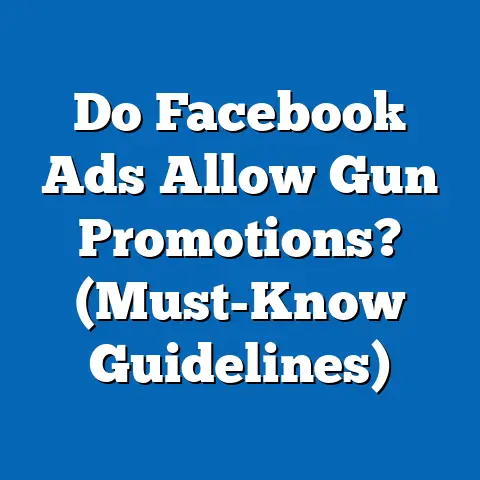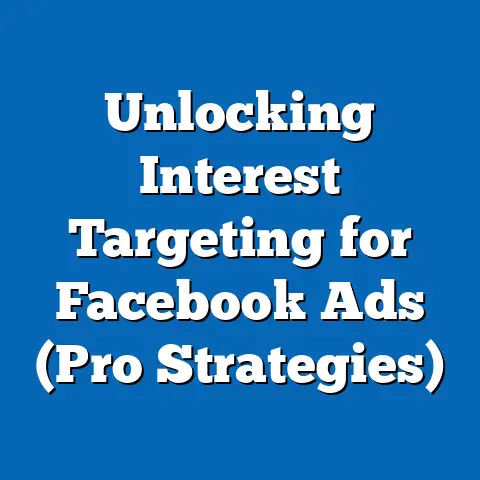Why Is Facebook All Ads? (Uncover the Hidden Strategy)
In today’s digital landscape, we’re constantly bombarded with information. It’s a relentless stream of updates, notifications, and content vying for our attention. This overwhelming influx has led to what I call “information overload,” a state where we’re so inundated that it becomes difficult to process and retain anything. Facebook, as one of the largest social media platforms, has developed a unique strategy to navigate this noise, a strategy that, to many users, makes it feel like Facebook is “all ads.” But is it really just about squeezing every last penny from advertisers? I believe there’s a deeper, more nuanced strategy at play, one that aims to reduce the noise by delivering highly targeted and, ideally, relevant advertisements. This approach benefits not only the platform and its advertisers but, theoretically, also enhances the user experience. Let’s dive into the hidden strategy behind Facebook’s ad-heavy landscape.
The Evolution of Facebook’s Advertising Strategy
Facebook’s journey to becoming an advertising powerhouse is a fascinating one. It wasn’t always wall-to-wall ads. In its early days, Facebook was primarily a social networking site focused on connecting people. Think back to the clean, uncluttered profiles and simple status updates. But as the platform grew, so did the need for monetization.
Here’s a quick timeline of key milestones:
- Early Days (2004-2006): Limited advertising, mostly focused on banner ads and partnerships. The focus was on user growth and engagement.
- The News Feed (2006): A game-changer. This algorithmically curated stream of content provided a perfect canvas for integrating ads more seamlessly.
- Facebook Pages (2007): Businesses could now create dedicated pages to connect with fans and, eventually, advertise to them.
- Self-Serve Ad Platform (2007): This democratized advertising, allowing businesses of all sizes to create and manage their own campaigns.
- Mobile Shift (Early 2010s): As mobile usage exploded, Facebook adapted its advertising strategy to mobile-first, optimizing ad formats and targeting for smaller screens.
- Sophisticated Targeting (Ongoing): Facebook’s data-driven targeting capabilities became increasingly refined, allowing advertisers to reach highly specific audiences based on demographics, interests, behaviors, and more.
- Ad Formats Galore (Ongoing): From image ads to video ads, carousel ads to lead generation ads, Facebook constantly introduces new ad formats to cater to different marketing objectives.
This evolution has been driven by a desire to create a more personalized user experience. By delivering ads that are relevant to users’ interests, Facebook aims to make advertising less intrusive and more helpful. But the primary driver, let’s be honest, is revenue. According to Statista, Facebook’s advertising revenue has grown exponentially over the years, reaching over \$116 billion in 2022. This growth is a testament to the effectiveness of Facebook’s advertising strategy and its ability to generate value for advertisers.
Takeaway: Facebook’s advertising strategy has evolved dramatically over the years, driven by a need for monetization and a desire to create a more personalized user experience.
The Economics of Attention
In the digital age, attention is the new currency. We have a finite amount of it, and countless entities are vying for it. Facebook has masterfully capitalized on this reality by creating a marketplace for attention, where advertisers bid for the opportunity to capture users’ focus.
Think of it like this: Facebook is the landlord of a bustling city, and its users are the residents. Advertisers are businesses trying to attract customers. They pay Facebook rent (ad spend) to place their storefronts (ads) in high-traffic areas (users’ News Feeds). The higher the rent, the better the location and the more likely they are to attract attention.
The mechanics of Facebook’s bidding system are complex, but the basic principle is simple: advertisers set a budget and bid on various parameters, such as demographics, interests, and behaviors. Facebook’s algorithms then determine which ads to show to which users based on a combination of factors, including bid amount, ad quality, and estimated action rates.
This economic model incentivizes Facebook to prioritize ads in users’ feeds. The more ads they show, the more revenue they generate. However, Facebook also needs to balance this with user experience. Show too many irrelevant ads, and users will become annoyed and disengage. That’s why Facebook focuses on delivering targeted ads that are relevant to users’ interests.
But even with the best targeting, the sheer volume of ads can be overwhelming. This is why many users feel like Facebook is “all ads.” It’s not necessarily that the ads are irrelevant, but rather that there are just so many of them competing for our attention.
Takeaway: Facebook’s advertising model is built on the economics of attention, where advertisers bid for the opportunity to capture users’ focus. This incentivizes Facebook to prioritize ads in users’ feeds, leading to the perception that the platform is “all ads.”
User Behavior and Engagement Metrics
Facebook’s ad strategy isn’t just about showing ads; it’s about showing the right ads to the right people at the right time. To achieve this, Facebook relies heavily on tracking user behavior and engagement metrics.
Everything you do on Facebook – from liking a post to joining a group to watching a video – is tracked and analyzed. This data is then used to build a detailed profile of your interests, preferences, and behaviors. This is the foundation of Facebook’s sophisticated targeting capabilities.
But it’s not just about targeting. Facebook also uses engagement metrics to determine which types of content (including ads) resonate most with users. The more engagement an ad receives (likes, comments, shares, clicks), the more likely it is to be shown to other users.
This creates a feedback loop. Ads that are engaging are shown to more people, which in turn generates more engagement. This further reinforces the algorithm’s belief that the ad is relevant and valuable. As a result, users are often exposed to a higher volume of advertisements that are deemed to be engaging, contributing to the “all ads” perception.
Advertisers leverage these metrics to refine their campaigns. By analyzing which ads are performing well and which are not, they can optimize their targeting, creative, and bidding strategies. This results in a constant cycle of improvement, leading to more effective and engaging ads.
I’ve seen this firsthand with my own campaigns. By closely monitoring metrics like click-through rate (CTR), conversion rate, and cost-per-acquisition (CPA), I’ve been able to identify areas for improvement and optimize my campaigns for better performance. This data-driven approach is essential for success on Facebook.
Takeaway: Facebook tracks user behavior and engagement metrics to determine which types of content (including ads) resonate most with users. This creates a feedback loop that further entrenches ads into the user experience.
The Role of Data Privacy and Regulation
The rise of data privacy concerns and regulations like GDPR (General Data Protection Regulation) and CCPA (California Consumer Privacy Act) have had a significant impact on Facebook’s advertising strategy. These regulations have forced Facebook to adapt its practices, but they haven’t diminished its reliance on targeted advertising.
GDPR, for example, requires companies to obtain explicit consent from users before collecting and processing their personal data. This has forced Facebook to be more transparent about its data collection practices and to give users more control over their data.
Similarly, CCPA gives California residents the right to know what personal information businesses collect about them, the right to delete that information, and the right to opt out of the sale of their personal information.
These regulations have made it more challenging for Facebook to collect and use data for advertising purposes. However, Facebook has adapted by developing new technologies and strategies that allow it to continue delivering targeted ads while respecting user privacy.
For example, Facebook has invested heavily in privacy-enhancing technologies like differential privacy and federated learning. These technologies allow Facebook to analyze data without directly accessing individual user data.
Facebook has also introduced new advertising options that allow advertisers to target users based on aggregated data rather than individual data. This allows advertisers to reach specific audiences without compromising user privacy.
Despite these efforts, Facebook has faced criticism and regulatory pressure over its data privacy practices. The company has been fined billions of dollars for violating privacy laws and has been forced to make significant changes to its data collection and advertising practices.
The balance Facebook must strike between user privacy and delivering personalized ad experiences is a delicate one. The company needs to comply with regulations and respect user privacy while also maintaining its ability to generate revenue from advertising.
Takeaway: Data privacy concerns and regulations like GDPR and CCPA have forced Facebook to adapt its advertising practices, but they haven’t diminished its reliance on targeted advertising.
The Future of Facebook Advertising
The future of Facebook advertising is uncertain, but one thing is clear: it will continue to evolve in response to emerging technologies, changing user expectations, and regulatory pressures.
One potential shift is the rise of ad-blocking tools. As users become more aware of the pervasiveness of online advertising, they may turn to ad-blocking tools to filter out unwanted ads. This could significantly impact Facebook’s advertising revenue.
Another trend to watch is the increasing use of artificial intelligence (AI) and machine learning (ML) in ad targeting and personalization. AI and ML can be used to analyze vast amounts of data and identify patterns that would be impossible for humans to detect. This could lead to even more precise and effective ad targeting.
I also believe that Facebook will need to find new ways to engage users beyond traditional advertising. This could include investing in new content formats, such as augmented reality (AR) and virtual reality (VR), or developing new social experiences that are less reliant on advertising.
Ultimately, the future of Facebook advertising will depend on the company’s ability to innovate and adapt to changing market conditions. Facebook needs to find new ways to deliver value to both advertisers and users while respecting user privacy and complying with regulations.
Takeaway: The future of Facebook advertising is uncertain, but it will likely be shaped by emerging technologies, changing user expectations, and regulatory pressures. Facebook will need to innovate and adapt to maintain its relevance and profitability.
Conclusion
Facebook’s dominance of advertisements is not merely a byproduct of its business model but a carefully crafted strategy designed to maximize user engagement and revenue. By understanding the evolution of Facebook’s advertising strategy, the economics of attention, the role of user behavior and engagement metrics, the impact of data privacy and regulation, and the future trends shaping the industry, we can gain a deeper appreciation for the complexities of Facebook’s ad-heavy landscape.
The implications of this advertising strategy for the future of social media and digital communication are profound. As social media platforms become increasingly reliant on advertising revenue, it’s important to consider the impact on user experience, data privacy, and the overall health of the digital ecosystem. What responsibility do these platforms have to balance their financial interests with the needs and rights of their users? This is a question that will continue to be debated and explored in the years to come.





